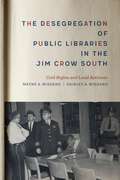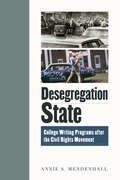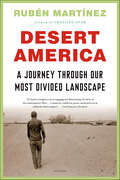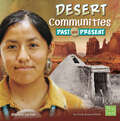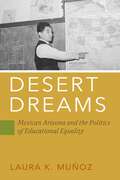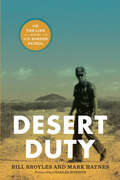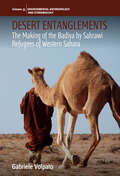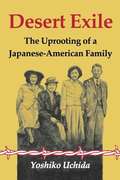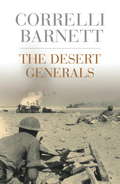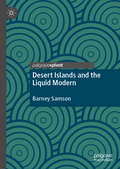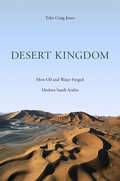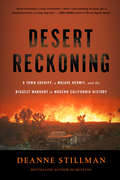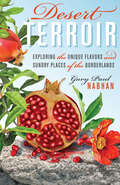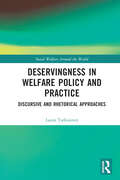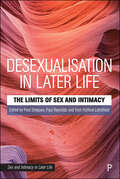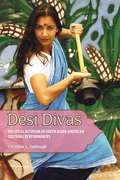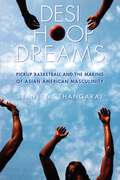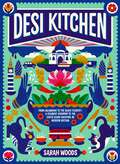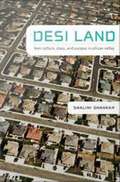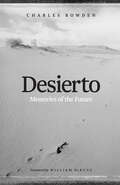- Table View
- List View
The Desegregation of Public Libraries in the Jim Crow South: Civil Rights and Local Activism
by Shirley A. Wiegand Wayne A. WiegandIn The Desegregation of Public Libraries in the Jim Crow South, Wayne A. and Shirley A. Wiegand tell the comprehensive story of the integration of southern public libraries. As in other efforts to integrate civic institutions in the 1950s and 1960s, the determination of local activists won the battle against segregation in libraries. In particular, the willingness of young black community members to take part in organized protests and direct actions ensured that local libraries would become genuinely free to all citizens.The Wiegands trace the struggle for equal access to the years before the Supreme Court’s Brown v. Board of Education decision, when black activists in the South focused their efforts on equalizing accommodations, rather than on the more daunting—and dangerous—task of undoing segregation. After the ruling, momentum for vigorously pursuing equality grew, and black organizations shifted to more direct challenges to the system, including public library sit-ins and lawsuits against library systems. Although local groups often took direction from larger civil rights organizations, the energy, courage, and determination of younger black community members ensured the eventual desegregation of Jim Crow public libraries. The Wiegands examine the library desegregation movement in several southern cities and states, revealing the ways that individual communities negotiated—mostly peacefully, sometimes violently—the integration of local public libraries.This study adds a new chapter to the history of civil rights activism in the mid-twentieth century and celebrates the resolve of community activists as it weaves the account of racial discrimination in public libraries through the national narrative of the civil rights movement.
Desegregation State: College Writing Programs after the Civil Rights Movement
by Annie S. MendenhallThe only book-length study of the ways that postsecondary desegregation litigation and policy affected writing instruction and assessment in US colleges, Desegregation State provides a history of federal enforcement of higher education desegregation and its impact on writing programs from 1970 to 1988. Focusing on the University System of Georgia and two of its public colleges in Savannah, one a historically segregated white college and the other a historically Black college, Annie S. Mendenhall shows how desegregation enforcement promoted and shaped writing programs by presenting literacy remediation and testing as critical to desegregation efforts in southern and border states. Formerly segregated state university systems crafted desegregation plans that gave them more control over policies for admissions, remediation, and retention. These plans created literacy requirements—admissions and graduation tests, remedial classes, and even writing centers and writing across the curriculum programs—that reshaped the landscape of college writing instruction and denied the demands of Black students, civil rights activists, and historically Black colleges and universities for major changes to university systems. This history details the profound influence of desegregation—and resistance to desegregation—on the ways that writing is taught and assessed in colleges today. Desegregation State provides WPAs and writing teachers with a disciplinary history for understanding racism in writing assessment and writing programs. Mendenhall brings emerging scholarship on the racialization of institutions into the field, showing why writing studies must pay more attention to how writing programs have institutionalized racist literacy ideologies through arguments about student placement, individualized writing instruction, and writing assessment.
Desert America: A Journey Through Our Most Divided Landscape
by Rubén MartínezA brilliantly illuminating portrait of the twenty-first-century West—a book as vast, diverse, and unexpected as the land and the people, from one of our foremost chroniclers of migrationThe economic boom—and the devastation left in its wake—has been writ nowhere as large as on the West, the most iconic of American landscapes. Over the last decade the West has undergone a political and demographic upheaval comparable only to the opening of the frontier. Now, in Desert America, a work of powerful reportage and memoir, Rubén Martínez, acclaimed author of Crossing Over, evokes a new world of extremes: outrageous wealth and devastating poverty, sublime beauty and ecological ruin. In northern New Mexico, an epidemic of drug addiction flourishes in the shadow of some of the country's richest zip codes; in Joshua Tree, California, gentrification displaces people and history. In Marfa, Texas, an exclusive enclave triggers a race war near the banks of the Rio Grande. And on the Tohono O'odham reservation, Native Americans hunt down Mexican migrants crossing the most desolate stretch of the border.With each desert story, Martínez explores his own encounter with the West and his love for this most contested region. In the process, he reveals that the great frontier is now a harbinger of the vast disparities that are redefining the very idea of America.
Desert Communities Past and Present (Who Lived Here?)
by Cindy Jenson-ElliottThe Cahuilla Indians have lived in the hot, dry desert for thousands of years. Learn how they have survived and thrived in this harsh environment and how their lives have changed and remained the same as the world has changed around them.
Desert Dreams: Mexican Arizona and the Politics of Educational Equality (Politics and Culture in Modern America)
by Laura K. MuñozMexican Arizona and the Politics of Educational Equality
Desert Duty: On the Line with the U.S. Border Patrol
by Bill Broyles Mark HaynesWhile politicians and pundits endlessly debate immigration policy, U.S. Border Patrol agents put their lives on the line to enforce immigration law. In a day’s work, agents may catch a load of narcotics, apprehend groups of people entering the country illegally, and intercept a potential terrorist. Their days often include rescuing aliens from death by thirst or murder by border bandits, preventing neighborhood assaults and burglaries, and administering first aid to accident victims, and may involve delivering an untimely baby or helping stranded motorists. As Bill Broyles and Mark Haynes sum it up, “Border Patrol is a hero job,” one that too often goes unrecognized by the public. Desert Duty puts a human face on the Border Patrol. It features interviews with nineteen active-duty and retired agents who have worked at the Wellton, Arizona, station that watches over what is arguably the most perilous crossing along the border—a sparsely populated region of the Sonoran Desert with little water and summer temperatures that routinely top 110°F. The agents candidly discuss the rewards and frustrations of holding the line against illegal immigrants, smugglers, and other criminals—while often having to help the very people they are trying to thwart when they get into trouble in the desert. As one agent explains, “The thrill is tracking ’em up before they die. It’s a rough ol’ way to go—run outta water in this desert.”
Desert Duty: On the Line with the U.S. Border Patrol
by Bill Broyles Mark HaynesWhile politicians and pundits endlessly debate immigration policy, U. S. Border Patrol agents put their lives on the line to enforce immigration law. In a day's work, agents may catch a load of narcotics, apprehend groups of people entering the country illegally, and intercept a potential terrorist. Their days often include rescuing aliens from death by thirst or murder by border bandits, preventing neighborhood assaults and burglaries, and administering first aid to accident victims, and may involve delivering an untimely baby or helping stranded motorists. As Bill Broyles and Mark Haynes sum it up, "Border Patrol is a hero job," one that too often goes unrecognized by the public. Desert Duty puts a human face on the Border Patrol. It features interviews with nineteen active-duty and retired agents who have worked at the Wellton, Arizona, station that watches over what is arguably the most perilous crossing along the border-a sparsely populated region of the Sonoran Desert with little water and summer temperatures that routinely top 110°F. The agents candidly discuss the rewards and frustrations of holding the line against illegal immigrants, smugglers, and other criminals-while often having to help the very people they are trying to thwart when they get into trouble in the desert. As one agent explains, "The thrill is tracking 'em up before they die. It's a rough ol' way to go-run outta water in this desert. "
Desert Entanglements: The Making of the Badiya by Sahrawi Refugees of Western Sahara (Environmental Anthropology and Ethnobiology)
by Gabriele VolpatoThe Sahrawi refugees in southwestern Algeria have struggled from exile for fifty years to reconfigure the animated desert they call badiya. They recovered camel husbandry and access to part of the former rangeland, and wove it back as seasonal nomadism. Desert Entanglements analyzes this process as an act of place-making premised on refugees’ agency.
Desert Exile: The Uprooting of a Japanese-American Family
by Yoshiko UchidaDesert Exile chronicles the experiences of a well-to-do Japanese American family before and during the internment of Japanese-Americans during the Second World War.
The Desert Generals
by Correlli BarnettA classic account of the Desert Campaign of 1940-43, by a renowned military historian.The distinguished historian Correlli Barnett gives here a complete and full account of the Desert Campaign 1940-43, an epic story set in a wasteland where soldiers fought for victory in a tumult of mechanical warfare. But THE DESERT GENERALS is also the story of five men under the strain of command in battle, the commanders who successively led the Allied forces against first the Italians and then the Germans in the ebb and flow of the desert war, culminating in the myth of Montgomery and the battle of Alamein, a myth that Correlli Barnett sets out to expose as ill-founded.Brilliantly written, THE DESERT GENERALS captures at every level the intensity and human drama of a unique and compelling episode in the history of war and warfare.
The Desert Generals
by Correlli BarnettA classic account of the Desert Campaign of 1940-43, by a renowned military historian.The distinguished historian Correlli Barnett gives here a complete and full account of the Desert Campaign 1940-43, an epic story set in a wasteland where soldiers fought for victory in a tumult of mechanical warfare. But THE DESERT GENERALS is also the story of five men under the strain of command in battle, the commanders who successively led the Allied forces against first the Italians and then the Germans in the ebb and flow of the desert war, culminating in the myth of Montgomery and the battle of Alamein, a myth that Correlli Barnett sets out to expose as ill-founded.Brilliantly written, THE DESERT GENERALS captures at every level the intensity and human drama of a unique and compelling episode in the history of war and warfare.
Desert Islands and the Liquid Modern
by Barney SamsonThis book investigates desert islands in postwar anglophone popular culture, exploring representations in radio, print and screen advertising, magazine cartoons, cinema, video games, and comedy, drama and reality television. Drawing on Zygmunt Bauman’s theory of liquid modernity, desert island texts are analysed in terms of their intersections with repressive and seductive mechanisms of power. Chapters focus on the desert island as: a conflictingly in/coherent space that characterises identity as deferred and structured by choice; a location whose ‘remoteness’ undermines satirical critiques of communal identity formation; a site whose ambivalent relationship with ‘home’ and Otherness destabilises patriarchal ‘Western’ subjectivity; a space bound up with mobility and instantaneity; and an expression of radical individuality and underdetermined identity. The desert island in popular culture is shown to reflect, endorse and critique a profoundly consumerist society that seduces us with promises of coherence, with the threat of repression looming if we do not conform.
Desert Kingdom: How Oil and Water Forged Modern Saudi Arabia
by Toby Craig JonesOil and water, and the science and technology used to harness them, have long been at the heart of political authority in Saudi Arabia. Oil’s abundance, and the fantastic wealth it generated, has been a keystone in the political primacy of the kingdom’s ruling family. The other bedrock element was water, whose importance was measured by its dearth. Over much of the twentieth century, it was through efforts to control and manage oil and water that the modern state of Saudi Arabia emerged. The central government’s power over water, space, and people expanded steadily over time, enabled by increasing oil revenues. The operations of the Arabian American Oil Company proved critical to expansion and to achieving power over the environment. Political authority in Saudi Arabia took shape through global networks of oil, science, and expertise. And, where oil and water were central to the forging of Saudi authoritarianism, they were also instrumental in shaping politics on the ground. Nowhere was the impact more profound than in the oil-rich Eastern Province, where the politics of oil and water led to a yearning for national belonging and to calls for revolution. Saudi Arabia is traditionally viewed through the lenses of Islam, tribe, and the economics of oil. Desert Kingdom now provides an alternative history of environmental power and the making of the modern Saudi state. It demonstrates how vital the exploitation of nature and the roles of science and global experts were to the consolidation of political authority in the desert.
Desert Reckoning: A Town Sheriff, a Mojave Hermit, and the Biggest Manhunt in Modern California History
by Deanne StillmanAward-winning nonfiction author Stillman offers a novelistic depiction of the Mojave Desert manhunt for Donald Kueck, a desert hermit who shot and killed deputy sheriff Stephen Sorensen when Sorensen approached Kueck's trailer on a routine check. She begins with background on the violent history of the desert region, then depicts present-day Antelope Valley, an hour's drive north of Los Angeles, as a place where loners and outcasts build make-shift homesteads. Stillman's narrative gets into the minds of both men as they navigate the territory of one of the last American frontiers. The book is based on Stillman's Rolling Stone article, "The Great Mojave Manhunt. " Each chapter opens with a b&w image of the region. Stillman teaches in the MFA Creative Writing Program at the University of California-Riverside-Palm Desert. Annotation ©2012 Book News, Inc. , Portland, OR (booknews. com)
The Desert Remembers My Name: On Family and Writing (Camino del Sol)
by Kathleen J. AlcalaAlthough the essays are in many ways personal, they are also universal. When she examines her family history, she is encouraging us to inspect our own families, too. When she investigates a family secret, she is supporting our own search for meaning. And when she writes that being separated from our indigenous culture is “a form of illiteracy,” we know exactly what she means.
DESERT TERROIR: Exploring the Unique Flavors and Sundry Places of the Borderlands (Ellen and Edward Randall Series)
by Gary Paul NabhanWhy does food taste better when you know where it comes from? Because history-ecological, cultural, even personal-flavors every bite we eat. Whether it's the volatile chemical compounds that a plant absorbs from the soil or the stories and memories of places that are evoked by taste, layers of flavor await those willing to delve into the roots of real food. In this landmark book, Gary Paul Nabhan takes us on a personal trip into the southwestern borderlands to discover the terroir-the "taste of the place"-that makes this desert so delicious. To savor the terroir of the borderlands, Nabhan presents a cornucopia of local foods-Mexican oregano, mesquite-flour tortillas, grass-fed beef, the popular Mexican dessert capirotada, and corvina (croaker or drum fish) among them-as well as food experiences that range from the foraging of Cabeza de Vaca and his shipwrecked companions to a modern-day camping expedition on the Rio Grande. Nabhan explores everything from the biochemical agents that create taste in these foods to their history and dispersion around the world. Through his field adventures and humorous stories, we learn why Mexican oregano is most potent when gathered at the most arid margins of its range-and why foods found in the remote regions of the borderlands have surprising connections to foods found by his ancestors in the deserts of the Mediterranean and the Middle East. By the end of his movable feast, Nabhan convinces us that the roots of this fascinating terroir must be anchored in our imaginations as well as in our shifting soils.
Desertification, Land Degradation and Sustainability
by Anton ImesonDesertification offers a comprehensive overview of the subject and clearly emphasizes the link between local and global desertification processes and how past and current policy has affected arid environments and their populations.This text adequately applies the research undertaken during the last 15 years on the topic. Desertification has become increasingly politicized and there is a need to present and explain the facts from a global perspective. This book tackles the issues surrounding desertification in a number of ways from differing scales (local to global), processes (physical to human), the relationship of desertification to current global development and management responses at different scales. Desertification has been mainstreamed and integrated into other areas of concern and has consequently been ignored as a cross cutting issue. The book redresses this balance.Making use of much original data and information that has been undertaken by many scientists andpractitioners during the last decade in different parts of the world, Desertification, Land Degradation and Sustainability is organised according to the principles of adaptive management and hierarchy theory and clearly explains desertification within a framework of evolving and interacting physical and socio-economic systems. In addition to research data the book also draws from the National Action Plans of different countries, the IPCC Fourth Assessment on Climate Change and the Millennium assessments.Clearly structured throughout, the content of the book is organised at different scales; local, regional and global. It also specifically explains processes linking top-down and bottom- up interactions and has a strong human component. The historical, cultural and physical context is also stressed.Clearly organised into the following distinct sections:a) Concepts and processesb) Datac) Impactsd) Responsese) Case studies.This text is essential for anyone studying desertification as part of an earth and environmental science degree.
Deservingness in Welfare Policy and Practice: Discursive and Rhetorical Approaches (Social Welfare Around the World)
by Laura TarkiainenThis book discusses and illustrates how deservingness can be approached as a discursively and rhetorically accomplished phenomenon having varied empirical consequences with regard to welfare, poverty, class and care arrangements. Providing a thorough analysis of how deservingness representations are generated in the twenty-first century by focusing on the analysis of discourse and rhetoric of policymakers, reality TV participants, frontline workers and unemployed individuals, it shows that different actors actively participate in constructing representations of deservingness through which variety of political, practical and social implications and objectives are achieved and performed. The book addresses key themes such as: • What kinds of rhetorical and discursive tactics can be associated with un/deservingness? • How deservingness is accomplished as a speech act? • How different actors such as policymakers, reality TV programme participants, frontline workers and individual citizens participate in constructing un/deservingness? • What kind of practical implications and consequences deservingness representations have for policy making, frontline work and research This book will be of interest to all scholars and students of social policy, social work, sociology, social psychology, political science and media studies.
Desexualisation in Later Life: The Limits of Sex and Intimacy (Sex and Intimacy in Later Life)
by Paul SimpsonDespite evidence of a more sexually active ‘third age’, ageing and later life (50+) are still commonly represented as a process of desexualisation. Challenging this assumption and ageist stereotypes, this interdisciplinary volume investigates the experiential and theoretical landscapes of older people’s sexual intimacies, practices and pleasures. Contributors explore the impact of desexualisation in various contexts and across different identities, orientations, relationships and practices. This enlightening text, reflecting international scholarship, considers how we can distinguish the real challenges faced by older people from the prejudices imposed on them.
Desexualization in American Life (Classics In Communication And Mass Culture Ser.)
by Charles WinickOriginally published as The New People, this classic volume examines the great changes in popular culture that unfolded in the 1960s with major steps toward political, racial, gender, and social empowerment. The popular culture of the time expressed a series of themes that have become, if not more significant, then certainly more visible in the 1990s. We are now entering the third generation of Americans who are living out the themes that are traced in this book.The author sees a depolarization, a neutering in content and key people in the popular arts. Some of these trends result from technological changes and others reflect what is happening in the psychosocial interior of the family as well as larger economic movements. Winick believes that in such wide-ranging features of our society as sports, furniture, and architecture, the expression of an epoch can be identified. Clothing conveys the imbalance and ambiguity that reflect larger social forces and that have been identified more recently by Jacques Lacan as so important in modern life. Desexualization in American Life is remarkably prescient and accurate in identifying key trends that affect us today and will continue to do so for the remainder of the decade.
Desi Divas: Political Activism in South Asian American Cultural Performances
by Christine L. GarloughDesi Divas: Political Activism in South Asian American Cultural Performances is the product of five years of field research with progressive activists associated with the School for Indian Languages and Cultures (SILC), South Asian Americans Leading Together (SAALT), the feminist dance collective Post Natyam, and the grassroots feminist political organization South Asian Sisters. Christine L. Garlough explores how traditional cultural forms may be critically appropriated by marginalized groups and used as rhetorical tools to promote deliberation and debate, spur understanding and connection, broaden political engagement, and advance particular social identities. Within this framework she examines how these performance activists advocate a political commitment to both justice and care, to both deliberative discussion and deeper understanding. To consider how this might happen in diasporic performance contexts, Garlough weaves together two lines of thinking. One grows from feminist theory and draws upon a core literature concerning the ethics of care. The other comes from rhetoric, philosophy, and political science literature on recognition and acknowledgment. This dual approach is used to reflect upon South Asian American women's performances that address pressing social problems related to gender inequality, immigration rights, ethnic stereotyping, hate crimes, and religious violence. Case study chapters address the relatively unknown history of South Asian American rhetorical performances from the early 1800s to the present. Avant-garde feminist performances by the Post Natyam dance collective appropriate women's folk practices and Hindu goddess figures make rhetorical claims about hate crimes against South Asian Americans after 9/11. In Yoni ki Bat (a South Asian American version of The Vagina Monologues) a progressive performer transforms aspects of the Mahabharata narrative to address issues of sexual violence, such as incest and rape. Throughout the volume, Garlough argues that these performers rely on calls for acknowledgment that intertwine calls for justice and care. That is, they embed their testimony in traditional cultural forms to invite interest, reflection, and connection.
Desi Hoop Dreams: Pickup Basketball and the Making of Asian American Masculinity
by Stanley I. ThangarajSouth Asian American men are not usually depicted as ideal American men. They struggle against popular representations as either threatening terrorists or geeky, effeminate computer geniuses. To combat such stereotypes, some use sports as a means of performing a distinctly American masculinity. Desi Hoop Dreams focuses on South Asian-only basketball leagues common in most major U.S. and Canadian cities, to show that basketball, for these South Asian American players is not simply a whimsical hobby, but a means to navigate and express their identities in 21st century America.The participation of young men in basketball is one platform among many for performing South Asian American identity. South Asian-only leagues and tournaments become spaces in which to negotiate the relationships between masculinity, race, and nation. When faced with stereotypes that portray them as effeminate, players perform sporting feats on the court to represent themselves as athletic. And though they draw on black cultural styles, they carefully set themselves off from African American players, who are deemed “too aggressive.” Accordingly, the same categories of their own marginalization—masculinity, race, class, and sexuality—are those through which South Asian American men exclude women, queer masculinities, and working-class masculinities, along with other racialized masculinities, in their effort to lay claim to cultural citizenship.One of the first works on masculinity formation and sport participation in South Asian American communities, Desi Hoop Dreams focuses on an American popular sport to analyze the dilemma of belonging within South Asian America in particular and in the U.S. in general.
Desi Kitchen
by Sarah WoodsJoin Sarah Woods on a mouth-watering celebration of British and South Asian fusion recipes, featuring the Desi communities who created them'I've longed for a book like this. A fascinating read with glorious recipes' DIANA HENRY'An evocative visual feast that speaks to your very heart. The mouth-watering recipes leap off the page and I am left wanting to bookmark nearly every dish' LARA LEE, author of Coconut and Sambal'Beautiful book, great recipes, really well written and original' PRUE LEITH____________Sarah Woods has spent her whole life surrounded by a fusion of South Asian and British cooking. Now, she speaks to the many desi communities across the UK to provide a unique culinary roadmap to the diaspora of the Indian subcontinent in Britain today.Travelling from the Pakistani community of Glasgow to the Nepalese community of Kent and everywhere in between, the book explores how groups from different regions have blended their food and culture to create a cuisine that is distinct, special and diverse.With Sarah's expert guidance, you will . . .- Cook Gujarati Hasselback Potato Shaak for an alternative take on a side dish- Make a Ugandan Chapatti Rolex for a great way to use leftover curry- Sticky and Spicy Mango Chicken Wings are quick and easy to make and finger licking good- Try Welsh Chilli Rarebit with curry oil and crispy shallots- Dive into Peshawari Bread and Butter Pudding with honeyed figsPacked with recipes, stories and authentic voices from each of the communities covered, Sarah Woods, finalist of BBC One's Britain's Best Home Cook and herself a second-generation Punjabi, has brought together this collection of mouth-watering dishes and provided a rare and privileged glimpse into desi kitchens from all over modern Britain.____________'A mesmerising cookbook filled with gorgeous recipes from Desi kitchens all over modern Britain' ATUL KOCHHAR
Desi Land: Teen Culture, Class, and Success in Silicon Valley
by Shalini ShankarDesi Land is Shalini Shankar's lively ethnographic account of South Asian American teen culture during the Silicon Valley dot-com boom. Shankar focuses on how South Asian Americans, or "Desis," define and manage what it means to be successful in a place brimming with the promise of technology. Between 1999 and 2001 Shankar spent many months "kickin' it" with Desi teenagers at three Silicon Valley high schools, and she has since followed their lives and stories. The diverse high-school students who populate Desi Land are Muslims, Hindus, Christians, and Sikhs, from South Asia and other locations; they include first- to fourth-generation immigrants whose parents' careers vary from assembly-line workers to engineers and CEOs. By analyzing how Desi teens' conceptions and realizations of success are influenced by community values, cultural practices, language use, and material culture, she offers a nuanced portrait of diasporic formations in a transforming urban region. Whether discussing instant messaging or arranged marriages, Desi bling or the pressures of the model minority myth, Shankar foregrounds the teens' voices, perspectives, and stories. She investigates how Desi teens interact with dialogue and songs from Bollywood films as well as how they use their heritage language in ways that inform local meanings of ethnicity while they also connect to a broader South Asian diasporic consciousness. She analyzes how teens negotiate rules about dating and reconcile them with their longer-term desire to become adult members of their communities. In Desi Land Shankar not only shows how Desi teens of different socioeconomic backgrounds are differently able to succeed in Silicon Valley schools and economies but also how such variance affects meanings of race, class, and community for South Asian Americans.
Desierto: Memories of the Future
by Charles BowdenThe acclaimed author of Blue Desert explores life on the arid borderlands of southern Arizona in this “compelling and wonderfully poetic” essay collection (Ron Hansen, New York Times Book Review).In Desierto, Charles Bowden brings his signature eye for vivid detail and penetrating insight to the Sonoran Desert. Travelling across this unforgiving terrain, he explores struggling desert villages, bitter Indian feuds, and a rich history that transcends borders. He profiles notorious predators from mountain lions to drug lords and land barons. Through it all, Bowden offers prescient visions of a future in which the region’s age-old dramas replay themselves long into the future.“In these powerful epic tales of the Sonora Desert, Bowden peoples the harsh land on both sides of the US-Mexican border with saints and sinners, but his enduring hero is the desert itself.” —Kirkus Reviews
